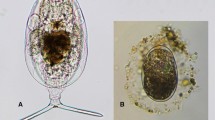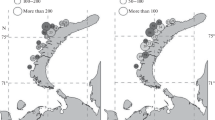Summary
Four brook-dwelling populations of Ancylus fluviatilis were studied. Data on life-cycle, specimen number, biomass and egg capsule biomass are reported. By means of experimental data on ingestion, assimilation, growth and egg-production, energy balances are calculated for whole populations.
Mean annual biomass turned out to be 26.58–64.88 mg C/m2. Mean annual biomass turn-over ratio (production/biomass) was 2.64–5.95. Cohort biomass turnover ratio was 4.11–6.09 for the whole population. Young specimens show considerably higher production efficiencies than adult ones. Production by the smallest size classes is a very considerable part of whole population production. Net production efficiency of the whole population was 11.2–11.8%, gross production efficiency 5.6–6.5%. An important factor for variation between different populations is temperature, but other factors, such as food supply, may be important, too. Experimental production estimates were compaerd with the Allen curve method and the instantaneous growth method.
Differences due to different methods of production measurement are discussed. The range of values for different efficiencies lies within the range reported for other freshwater snails. Interpopulation variation in turnover ratios nearly equals variation reported for different species of univoltine snails.
Similar content being viewed by others
References
Benedetto Castro, L.: Ökologie und Produktionsbiologie von Agapetus fuscipes Curt. im Breitenbach 1971–1972. Arch. Hydrobiol., Suppl. 45, 305–375 (1975)
Berg, K.: The problem of respiratory acclimatization. Hydrobiologia V, 331–350 (1953)
Burky, A. J.: Biomass turnover, respiration, and interpopulation variation in the stream limpet Ferrissia rivularis (Say). Ecol. Monogr. 41, 235–251 (1971)
Calow, P.: The food of Ancylus fluviatilis (Müll.), a littoral stone-dwelling, herbivore. Oecologia (Berl.) 16, 113–133 (1973)
Calow, P.: Some observations on locomotory strategies and their metabolic effects in two species of freshwater gastropods, Ancylus fluviatilis Müll. and Planorbis contortus (Linn.). Oecologia (Berl.) 16, 149–161 (1974)
Calow, P.: The feeding strategies of two freshwater gastropods, Ancylus fluviatilis Müll, and Planorbis contortus Linn. (Pulmonata), in terms of ingestion rates and absorption efficiencies. Oecologia (Berl.) 20, 33–49 (1975a)
Calow, P.: Defaecation strategies of two freshwater gastropods, Ancylus fluviatilis Müll. and Planorbis contortus Linn. (Pulmonata) with a comparison of field and laboratory estimates of food absorption rate. Oecologia (Berl.) 20, 51–63 (1975b)
Geldiay, R.: Studies on local populations of the freshwater limpet Ancylus fluviatilis Müller. J. anim. Ecol. 25, 389–402 (1956)
Gillespie, D. M.: Population studies of four species of molluscs in the Madison River, Yellowstone National Park. Limnol. Oceanogr. 14, 101–114 (1969)
Hunter, R. D.: Growth fecundity, and bioenergetics in three populations of Lymnaea palustris in upstate New York. Ecology 56, 50–63 (1975)
Klekowski, R. Z., Fischer, E., Fischer, Z., Ivanova, M. B., Prus, T., Shushkina, E. A., Stachurska, T., Stepien, Z., Zyromska-Rudzka, H.: Energy budgets and energy transformation efficiencies of serval animal species of different feeding types. In: Z. Kajak, A. Hillbricht-Ilkowska, eds., Productivity problems of freshwaters, p. 749–763. Warszawa-Krakow: Panstowe Wydawnictwo Naukwowe 1972
Mann, K. H.: Energy transformations by a population of fish in the River Thames. J. anim. Ecol. 34, 253–275 (1965)
Mann, K. H.: Use of the Allen curve method for calculating benthic production. In: W. T. Edmondson, G. G. Winberg, eds., Secondary productivity in fresh waters, IBP Handbook No. 17. Oxford-Edinburgh: Blackwell 1971
McMahon, R. F.: Growth, reproduction and bioenergetic variation in three natural populations of a fresh water limpet Laevapex fuscus (C. B. Adams). Proc. malac. Soc. Lond. 41, 331–351 (1975)
Needham, P. R., Usinger, R. L.: Variability in the macrofauna of a single riffle in Prosser Creek, California, as indicated by the Surber Sampler. Hilgardia 24, 383–409 (1956)
Odum, E. P.: Fundamentals of ecology, 3rd ed. Philadelphia-London-Toronto: Saunders 1971
Otto, C.: Energetic relationships of the natural populations of Potamophylax cingulatus (Trichoptera) in a South Swedish stream. Oikos 26, 159–169 (1975)
Pandian, T. J.: Intake, digestion, absorption and conversion of food in the fishes Megalops cyprinoides and Ophiocephalus striatus. Marine Biol. 1, 16–32 (1967)
Ricklefs, R. E.: Ecology. London: Nelson 1973
Russel-Hunter, W.: Annual variations in growth and density in natural populations of freshwater snails in the west of Scotland. Proc. Zool. Soc. Lond. 136, 219–253 (1961)
Schwenk, W., Schwoerbel, J.: Untersuchungen zur Ernährungsbiologie und Lebensweise der Flußmützenschnecke Ancylus fluviatilis (O. F. Müller, 1974; Gastropoda, Basommatophora). Arch. Hydrobiol., Suppl. 42, 190–231 (1973)
Slobodkin, L. B.: Energy in animal ecology. In: J. B. Cragg, ed., Advances in ecological research, p. 69–101. London-New York: Academic Press 1962
Streit, B.: Populationsdynamik von Chaetogaster limnaei limnaei in einer Population von Ancylus fluviatilis. Arch. Hydrobiol., Suppl. 47, 106–118 (1974)
Streit, B.: Experimentelle Untersuchungen zum Stoffhaushalt von Ancylus fluviatilis (Gastropoda-Basomatophora). 1. Ingestion, Assimilation, Wachstum und Eiablage. Arch. Hydrobiol., Suppl. 47, 458–514 (1975a)
Streit, B.: Experimentelle Untersuchungen zum Stoffhaushalt von Ancylus fluviatilis (Gastropoda-Basommatophora). 2. Untersuchungen über Einbau und Umsatz des Kohlenstoffs. Arch. Hydrobiol., Suppl. 48, 1–46 (1975b)
Tominaga, H., Ichimura, S.: Ecological studies on the organic matter production in a mountain river ecosystem. Bot. Mag. (Tokyo) 79, 815–829 (1966)
Warren, C., Davis, G. E.: Laboratory studies on the feeding, bioenergetics, and growth of fish. In: S. D. Gerking, ed., The biological basis of freshwater fish production, p. 175–214. Oxford: Blackwell 1967
Waters, T. F., The turnover ratio in production ecology of freshwater invertebrates. Amer. Naturalist 103, 173–185 (1969)
Waters, T.F., Crawford, G. W.: Annual production of a stream mayfly population: A comparison of methods. Limnol. Oceanogr. 18, 286–296 (1973)
Winberg, G. G. (ed.). Methods for the estimation of production of aquatic animals. London-New York: Academic Press 1971
Author information
Authors and Affiliations
Additional information
Supported by the Deutsche Forschungsgemeinschaft.
Rights and permissions
About this article
Cite this article
Streit, B. Energy flow in four different field populations of Ancylus fluviatilis (Gastropoda-Basommatophora). Oecologia 22, 261–273 (1976). https://doi.org/10.1007/BF00344796
Received:
Issue Date:
DOI: https://doi.org/10.1007/BF00344796




